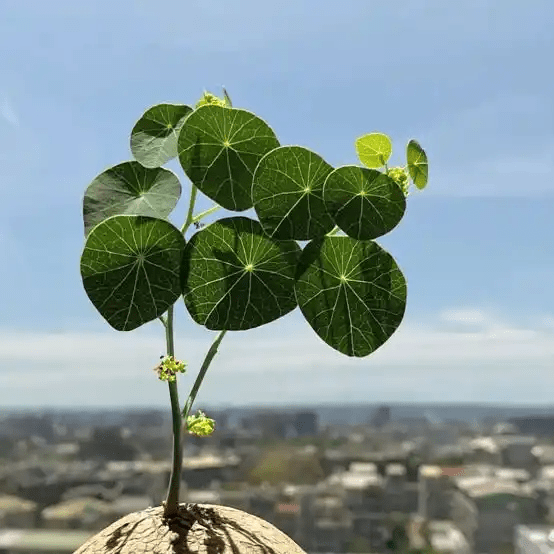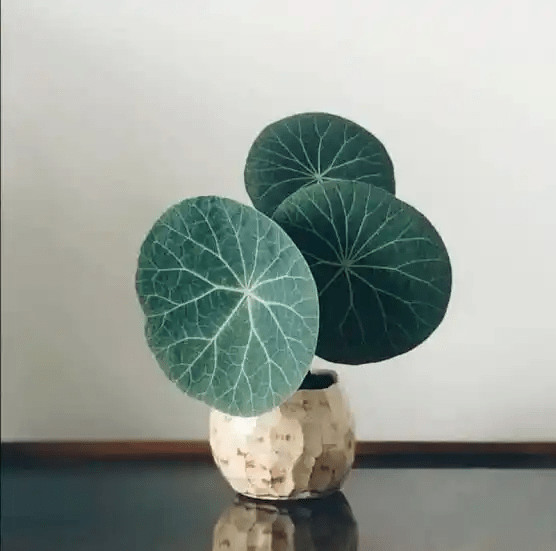Stephania is a genus of flowering plants that belongs to the family Menispermaceae. This genus includes various species of climbing or creeping vines and some small trees.
Stephania plants are primarily found in tropical and subtropical regions across Asia, Africa, and Australia.
One notable species within the Stephania genus is Stephania tetrandra. In traditional Chinese medicine, the root of Stephania tetrandra, known as Fang Ji, has been used for its potential diuretic and anti-inflammatory properties.
It has been traditionally employed to address conditions such as edema, arthritis, and joint pain.
Stephania plants often have tuberous roots and heart-shaped leaves. The flowers are typically inconspicuous, and the plants produce small, berry-like fruits. Some species are valued for their use in traditional medicine, while others may have ornamental qualities.
As with any medicinal plant, it’s essential to approach the use of Stephania or its specific species with caution. Different species within the genus may have varying chemical compositions and potential effects, and improper use can lead to adverse reactions.
In horticulture, Stephania tetrandra is sometimes cultivated for its ornamental foliage and as a climbing plant in gardens. Its heart-shaped leaves and twining habit can add aesthetic appeal to outdoor spaces.
It’s important to note that while traditional uses of Stephania species in herbal medicine exist, scientific research is ongoing, and the efficacy and safety of these plants may vary.
The Botanical Description of Stephania
Stephania is a genus of flowering plants in the family Menispermaceae. These perennial vines are characterized by their twining stems, which often climb on nearby vegetation for support. The botanical features of Stephania plants can vary among species.
1. Leaves: The leaves of Stephania plants are generally alternate and palmately lobed or compound. The leaf morphology can provide distinctive characteristics for species identification.
2. Flowers: The flowers of Stephania are often small and inconspicuous. They may be arranged in panicles or cymes, depending on the species. The color and structure of the flowers can differ, contributing to the diversity within the genus.
3. Fruits: Stephania produces fleshy fruits that contain seeds. The fruit morphology, including size and shape, can vary among species. Some species may have fruits that are attractive to wildlife.
4. Roots and Tubers: Many species of Stephania are known for their tuberous roots, which may have ethnobotanical significance. These roots can be large and have been used traditionally for various purposes.
The Geographic Distribution of Stephania
Stephania is a widely distributed genus, with various species found in different parts of the world. The geographic distribution can be influenced by factors such as climate, soil types, and elevation.
1. Tropical Regions: Many Stephania species thrive in tropical regions, where the climate provides the warmth and humidity conducive to their growth. Countries in Southeast Asia, Africa, and parts of South America host diverse species.
2. Temperate Zones: Some Stephania species can also be found in temperate zones, adapting to a slightly cooler climate. These may be present in parts of North America, Europe, and Asia with suitable conditions.
3. Altitudinal Range: The genus can exhibit a wide altitudinal range, with species growing at different elevations. This adaptability contributes to their presence in various ecosystems, from lowland forests to mountainous regions.
4. Habitats: Stephania plants can inhabit a range of habitats, including rainforests, deciduous forests, and savannas. The specific ecological niche occupied by each species may vary, influencing their distribution.
The Chemical Composition of Stephania
Stephania plants are known to contain a diverse array of phytochemicals, which contribute to their biological activities and potential uses.
1. Alkaloids: Many Stephania species are rich in alkaloids, secondary metabolites that often exhibit pharmacological properties. These alkaloids may have anti-inflammatory, analgesic, or antipyretic effects.
2. Tannins: Tannins, known for their astringent properties, are found in some Stephania species. These compounds may contribute to the plant’s traditional uses in wound healing or as astringents.
3. Flavonoids: Flavonoids are another group of compounds present in Stephania. These antioxidants may play a role in the plant’s ability to combat oxidative stress.
4. Glycosides: Some species of Stephania may contain glycosides, compounds with sugar molecules attached. These can have diverse physiological effects and may contribute to the plant’s traditional medicinal uses.
5. Essential Oils: In certain species, essential oils may be present, adding to the overall chemical complexity of Stephania plants. These oils can have aromatic and potentially therapeutic properties.
The botanical description, geographic distribution, and chemical composition of Stephania provides a foundation for exploring its ecological significance and potential applications, both traditional and contemporary.
Read Also: 17 Medicinal Health Benefits Of Smilax aristolochiifolia (Sarsaparilla)
The Medicinal Health Benefits Of Stephania

1. Anti-inflammatory Properties: Stephania exhibits anti-inflammatory effects, making it valuable for conditions involving inflammation, such as arthritis. Compounds within the plant may help reduce swelling and alleviate pain.
2. Analgesic Effects: The analgesic properties of Stephania make it beneficial for pain relief. It can be used to manage various types of pain, including musculoskeletal pain and headaches.
3. Antipyretic Action: Stephania may have antipyretic effects, helping to reduce fever. This makes it a potential remedy for febrile conditions and illnesses associated with elevated body temperature.
4. Immune System Support: Compounds found in Stephania may contribute to immune system support, enhancing the body’s ability to defend against infections and illnesses.
5. Antioxidant Benefits: The plant’s antioxidant properties can help combat oxidative stress, protecting cells from damage caused by free radicals. This is crucial for overall health and may contribute to disease prevention.
6. Gastrointestinal Health: Stephania is traditionally used to promote gastrointestinal health. It may help alleviate digestive issues, such as indigestion and bloating.
7. Respiratory Health: The plant may have benefits for respiratory health, including managing coughs and supporting the overall function of the respiratory system.
8. Cardiovascular Support: Stephania may contribute to cardiovascular health by helping to regulate blood pressure and improving overall heart function.
9. Diuretic Effects: Some species of Stephania exhibit diuretic effects, aiding in the elimination of excess fluids from the body. This can be beneficial for individuals with conditions such as edema.
10. Antifungal Properties: Stephania has demonstrated antifungal properties, suggesting its potential use in addressing fungal infections.
11. Wound Healing: Traditional uses of Stephania include its application for wound healing. The plant may have properties that promote skin regeneration and wound closure.
12. Menstrual Health: Stephania is sometimes used to address menstrual issues. It may help regulate menstrual cycles and alleviate associated discomfort.
13. Anticancer Potential: Preliminary research suggests that certain compounds in Stephania may have anticancer properties, although more studies are needed to confirm this potential.
14. Antiviral Effects: Some species of Stephania may exhibit antiviral effects, making them potentially useful in the prevention or treatment of viral infections.
15. Neuroprotective Properties: Stephania may have neuroprotective properties, offering support for brain health and potentially reducing the risk of neurodegenerative conditions.
16. Anti-anxiety and Relaxation: Traditional uses of Stephania include its application for promoting relaxation and reducing anxiety. Compounds within the plant may have calming effects on the nervous system.
The Methods of Usage to Achieve the Provided Health Benefits Of Stephania
1. Herbal Infusions: Prepare herbal infusions using dried Stephania leaves or roots. This method allows for the extraction of beneficial compounds through hot water.
2. Tinctures: Tinctures, made by extracting plant compounds in alcohol, provide a concentrated form of Stephania. They can be taken orally with water.
3. Poultices: Create poultices by applying crushed or powdered Stephania directly to the skin for localized benefits, such as wound healing.
4. Capsules or Tablets: Commercially available Stephania supplements in the form of capsules or tablets provide a convenient way to incorporate the plant into a daily routine.
5. Topical Ointments: Stephania ointments or creams can be applied topically to address skin conditions, wounds, or localized pain.
6. Inhalation: Inhaling the steam from boiled Stephania can benefit respiratory health. This method is particularly useful for managing coughs and congestion.
7. Culinary Use: In some cultures, Stephania is incorporated into culinary dishes. Consuming the plant as part of a meal can provide both flavor and health benefits.
8. Traditional Practices: Follow traditional practices and remedies as guided by local knowledge and cultural traditions. This may involve specific rituals or combinations with other herbs.
The Side Effects Of Using Stephania Medicinal Plant
1. Allergic Reactions: Some individuals may experience allergic reactions to Stephania. It’s essential to monitor for symptoms such as skin rash, itching, or swelling.
2. Gastrointestinal Upset: In some cases, Stephania use may cause gastrointestinal upset, including nausea or diarrhea. Adjusting the dosage or discontinuing use can alleviate these effects.
3. Interaction with Medications: Individuals taking medications, especially those with anticoagulant or antiplatelet effects, should consult with a healthcare professional before using Stephania to avoid potential interactions.
4. Pregnancy and Lactation: Pregnant and lactating individuals should exercise caution, as the safety of Stephania during these periods is not well-established. Consultation with a healthcare provider is advised.
5. Liver Health: Stephania has been associated with liver toxicity in some instances. Regular monitoring of liver function is recommended during prolonged use.
6. Central Nervous System Effects: Some reports suggest potential central nervous system effects. Individuals with neurological conditions or those taking medications affecting the nervous system should consult with a healthcare professional.
Read Also: 15 Medicinal Health Benefits of Barringtonia Macrostachya (Powder-puff Mangrove)
The Scientific Research and Studies of Stephania

1. Antioxidant and Anti-inflammatory Properties: Several scientific studies have explored the antioxidant and anti-inflammatory properties of Stephania. Research suggests that the plant’s compounds may help combat oxidative stress and inflammation, contributing to its potential health benefits.
2. Analgesic and Pain-Relieving Effects: Scientific investigations have delved into the analgesic effects of Stephania. Studies indicate its potential in providing pain relief, making it a subject of interest for conditions involving pain and discomfort.
3. Immunomodulatory Effects: Research has explored the immunomodulatory effects of Stephania, indicating its ability to modulate the immune system. This research provides insights into how Stephania may contribute to immune system support.
4. Gastroprotective Properties: Scientific studies have examined the gastroprotective properties of Stephania. Findings suggest its potential in promoting gastrointestinal health and protecting against certain digestive issues.
5. Cardiovascular Health: Studies have investigated the impact of Stephania on cardiovascular health. Research suggests that it may help regulate blood pressure and offer cardiovascular support, though further studies are needed for conclusive evidence.
6. Antifungal and Antimicrobial Activity: Scientific research has explored the antifungal and antimicrobial activity of Stephania. This makes it a subject of interest in addressing fungal infections and microbial-related health issues.
The Safety Precautions and Recommendations In Using Stephania Medicinal Plant
1. Allergy Testing: Before incorporating Stephania into your health regimen, it is advisable to conduct an allergy test. This can help identify potential allergic reactions and ensure safe usage.
2. Consultation with Healthcare Professionals: Individuals with pre-existing medical conditions or those taking medications should consult with healthcare professionals before using Stephania. This is crucial to prevent potential interactions and adverse effects.
3. Pregnancy and Lactation: Pregnant and lactating individuals should exercise caution when considering Stephania. The safety of its use during these periods is not well-established, and professional guidance is recommended.
4. Liver Function Monitoring: Due to reports of liver toxicity associated with Stephania use, regular monitoring of liver function is advised, especially for those using it over an extended period.
5. Quality Assurance: Ensure the quality of Stephania products by obtaining them from reputable sources. Quality assurance can minimize the risk of contamination or variability in plant composition.
FAQs About Stephania Medicinal Plant
1. Is Stephania Safe for Long-Term Use?
The safety of long-term Stephania use is not conclusively established. It is advisable to consult with a healthcare professional for personalized guidance.
2. Can Stephania Interact with Medications?
Stephania may interact with certain medications, especially those affecting the liver or blood clotting. Consultation with a healthcare provider is crucial for individuals on medication.
3. Are There Any Known Allergic Reactions to Stephania?
While allergic reactions are possible, they are not universally reported. Conducting an allergy test before regular use can help identify potential reactions.
4. How Does Stephania Contribute to Pain Relief?
Stephania’s analgesic effects are attributed to its impact on pain receptors and inflammatory pathways. Scientific studies have provided insights into its potential mechanisms of action.
5. Can Stephania Be Used Topically for Skin Conditions?
Yes, Stephania can be used topically for skin conditions. Poultices or ointments with Stephania may aid in wound healing and addressing skin issues.
6. Is Stephania Recommended for Children?
The use of Stephania in children should be approached with caution. Consultation with a pediatrician or healthcare professional is advised.
7. Does Stephania Have Central Nervous System Effects?
Some reports suggest potential central nervous system effects. Individuals with neurological conditions should exercise caution and seek professional advice.
8. What Precautions Should Be Taken During Pregnancy?
Pregnant individuals should avoid Stephania unless approved by a healthcare professional due to limited data on its safety during pregnancy.
9. Can Stephania Be Consumed as a Culinary Herb?
While Stephania is not commonly used in culinary practices, some cultures incorporate it into traditional dishes. However, its primary use is medicinal.
10. Is Stephania Recommended for Managing Respiratory Issues?
Stephania’s potential benefits for respiratory health make it a subject of interest, but individuals with respiratory conditions should seek professional advice before use.
11. How Does Stephania Affect the Immune System?
The immunomodulatory effects of Stephania are explored in research, suggesting its ability to modulate immune responses. However, individual responses may vary.
12. Can Stephania Be Used Alongside Other Herbal Remedies?
Combining Stephania with other herbal remedies should be done cautiously. Consultation with a healthcare professional can help determine safe combinations.
13. What Precautions Should Be Taken for Stephania Supplements?
Individuals using Stephania supplements should follow recommended dosages and quality standards. Regular health check-ups are advisable for those using supplements consistently.

